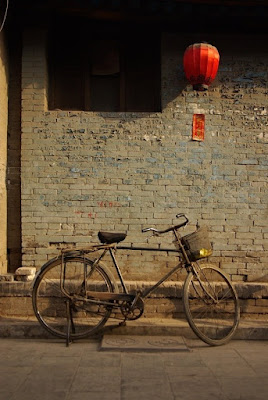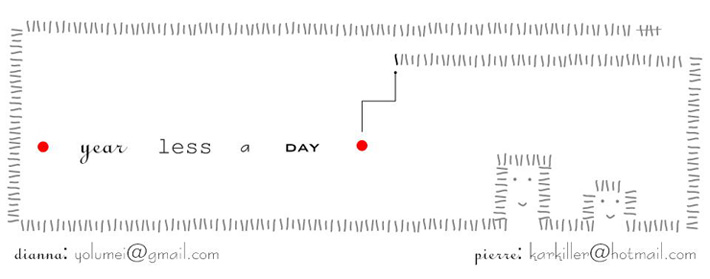PingYao (rhymes with ping-wow) is one of the few cities in China that missed the boat. Though the city was quite rich at other points in its history, the city became so poor in the 20th century that it couldn’t modernize like the rest of the country. Hence: real city walls, real city streets and genuinely old architecture. And instead of being a ghost town that simply caters to tourists, it’s still very much a lively residential area.
Pierre discovers the town through the guide and on Day 182 we take a 6 hour bus ride there to spend a few days.

Chinese long-distance buses are tame compared to Cambodia and Thailand. Sometimes there’s honking and swerving, but the buses are in good shape and usually include seatbelts (unlike the taxis). Also, the rest of traffic isn’t a total gong show, which helps. The bus drops us off on the highway, where a tuk-tuk style taxi is waiting for us, courtesy of our hostel. And, again unlike Cambodia, this time the number we called was real and we have a reservation.
Harmony guesthouse is in the center of town and the nicest hostel we’ve stayed in so far. In addition to being functional and fairly inexpensive (about 27 $CAN a night) it’s got personality. The bed is just a thick foam mat on a raised platform, but it’s king-sized and comfortable, and the room is bright, airy and colourful – a total pleasure to come back to at the end of a long day of walking.



Inside, the city has expanded to fill all the available space and a narrow road runs along the inside of the wall.

Up top there are lookouts…


Each point on the compass has a main gate that lets sightseers up or down the walls, which are high and steep:

The gates also serve as a tunnel from the city center to the rest of the city and small electric carts, bicycles and the occasional automobile zip in and out.


A large section of the city inside the walls is pedestrian-only during the day – from late at night until around 7 or 8 am, the metal barriers are open to let the city residents in and out, but during the day, it’s strictly feet and bicycles (and the occasional parked car that didn’t make it out on time).
The main street was traditionally the business center, and all of the shops that would have at one time sold merchandise for the locals now cater to tourists. The business area has similar architecture – a flat, wide face with hanging lanterns, lots of wood and latticed windows:

Near the gable of each building are usually a series of paintings (sometimes posters) of flowers, landscape and abstract designs.



The streets are packed with Chinese tourists:





…with the occasional glimpse at the yards hidden behind the walls:

In the streets, people go about their normal business. For the tourists, that involves walking around and taking pictures of everything. For the locals - mostly the elderly who don’t have to head off to work for the day - it involves settling in on a set of stairs or on low wall ledges to drink tea, play checkers and stare at all the foreigners that go by.
The residential area of the city is so monochrome and dusty that if this section of city was ever emptied to better preserve it, it would feel a bit like a graveyard. The people are the only things that keep this section of the city alive, and everywhere the people aren’t there are still signs of life – chalk alphabets practiced on walls, parked bicycles…


At night, the city has a completely different flavour, though the tourists still walk around in hordes (including us).

The main street is lit up with red lanterns and spot lights…




…and the smaller side streets are lit with lamps and the occasional bare bulb:



I see a lot of the afternoon and night life, but it’s mainly Pierre who manages to get up and out when our alarm clock goes off at 6:30 in the morning. I have good intentions, and want to head out, too, but I’m fighting off a cold and my body wants rest. Due to the way our door locks, I have to let Pierre in and out of the room on his morning excursions. Our conversation is limited to: I love you, I love you too, now please go away. Our days are much more chatty than our mornings. Eventually, Pierre catches a cold as well.
By day, we’re content to simply walk around, although we do try to go to a few of the local museums. The city center has a one-time two-day entrance fee to all the museums (about 15$CAN).
During the Qing dynasty (about 1650 to 1920), Ping Yao was China’s financial center and had China’s first bank – Rishengchang. The building is now a museum, with a few of its 100 rooms open to the public – reception rooms, bedrooms and offices…

…and kitchens.

The windows are a mix of those with panes of glass and those covered with sheets of paper:




…and around the back where we discover a small courtyard. We see a couple of teenage boys posing with swords and other ancient-style weapons that the museum has set out for tourists to pose/play with.
We love it. It’s not something we can imagine finding in North America: an unsupervised set of dull but authentic metal weapons with no warnings or rules other than a small yellow sign that says “Notice the safety.”
(This warning is slightly better worded than one we found in another building with smooth stairs:)

In spite of the casual attitude, there is a small unmanned room labeled “clinic” in the room behind the weapons, so presumably there is the occasional injury. Pierre goes straight for the swords…


(Pierre would like to mention here that he’s aware that he should be holding the mace in his back hand, as it’s much too heavy to be used as an effective weapon as shown in the picture. This only occurred to him as the picture was being taken, as you may notice from the look of uncomfortable concentration on his face. It remains, however, a very cool picture.)
We check out the Confucian Temple where people used to take the imperial exams to be become bureaucrats:




…and then check it off our list:

We drop into the City God Temple to walk around for a few minutes with its statues all covered in a thick layer of dust and incense ash:

As we’re wrapping up our walk on day 183, we run into a man in a yellow baseball cap. He walks over to us as we’re reviewing a few pictures on the camera screen and he asks if he can take a look, too. Since we’re standing near the electric carts, at first we wonder if he’s a driver looking to drum up business via some small talk. But the longer we talk with him the more we come to realize that he simply wants to talk. His name is Charlie, and he’s a laid-off/retired factory worker. He lives in Taiyuan with his daughter, but during the summer he comes to Ping Yao to live in a small one-room “apartment” and spend his day walking the city practicing English. He’s self-taught, using a couple of British textbooks with no CD. He simply talks to foreigners, practices what he’s learned, picks up a few new things here and there.
We visit with Charlie for about an hour, walking around the city. At the end, we give him our email address in case he wants to practice writing English, take a quick picture and then head off for dinner.

We bus back to Xi’An the next day, and then fly home to Huizhou on Day 185 – memory card full of pictures, head full of bad cold.


No comments:
Post a Comment